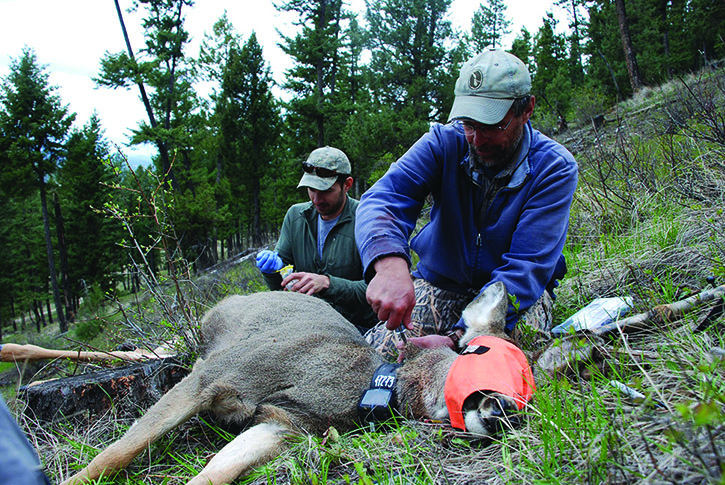The urban deer that have been moved from Invermere and several other East Kootenay communities as part of a pilot relocation study have shown better-than-expected survival rates and have impressed biologists with their movement patterns.
This winter, Cranbrook-based VAST Resource Solutions Inc. captured and moved of a total of 60 urban deer from the East Kootenay municipalities participating in the pilot study, including 13 from Invermere, translocating them into the backcountry (the deer caught in Invermere were moved to an area west of Canal Flats).
A total of 29 of the 60 deer (and seven of the 13 from Invermere) were fitted with GPS radio collars and their movement has since been tracked. So far eight of the 29 deer with collars have died, mostly from cougar predation.
“That’s just over 25 per cent mortality, which is better than many people thought the urban deer would suffer,” said project lead biologist Ian Adams in a press release. “The big surprise is that their movements have varied considerably — some moving over 300 kilometres, and others have stayed very close to their release site.”
The Echo attempted to contact Adams for further details, but was unable to reach him for comment prior to press deadline. He had previously told The Echo that, in the initial stages of monitoring, the study team had found some evidence that at least some of the urban deer moved from Invermere were integrating with wild mule deer herds.
“The Invermere deer are interesting in that they have moved quite little from their release point. They’ve stayed in a tight 10-square kilometre range. The deer relocated from the other communities have moved around a fair bit more,” Mr. Adams said at the time, adding he would “hesitate to speculate what that means, if it means anything at all.”
At the same time, the Ministry of Forests, Land and Natural Resource Operations (FLRNO) is continuing work on its five-year study analyzing the significant decline of wild mule deer in the Kootenay region, with the second year of the project having just wrapped up.
For the project, FLRNO biologists are studying the migrations patterns and causes of death of 88 wild mule deer in four areas around the Kootenay region, one of them — the Dutch Creek-Findlay Creek area — in the Upper Columbia Valley.
Although the project is not even half done yet, the biologists have already found some intriguing trends, with the different populations exhibiting quite distinct migration patterns. The mule deer in the far southeastern part of the Kootenay region, for instance, are moving much longer distance than the other groups, typically up to 60 kilometres a day and sometimes even ranging into Alberta.
“This is probably related to quality of habitat,” said project lead wildlife biologist Patrick Stent in a press release, later adding he was surprised to learn these deer “were crossing multiple big drainages to spend their summer in specific sites.”
Both projects are being partially funded by the Fish and Wildlife Compensation Program (FWCP) through the Upper Kootenay Ecosystem Enhancement Plan (UKEEP).
